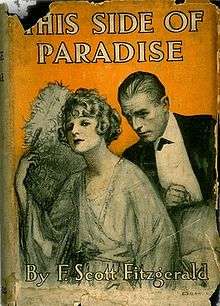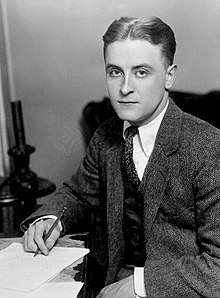This Side of Paradise
 Dust jacket cover of first edition | |
| Author | F. Scott Fitzgerald |
|---|---|
| Cover artist | W. E. Hill |
| Country | United States |
| Language | English |
| Genre | Novel |
| Publisher | Scribner |
Publication date | March 26, 1920 |
| Media type | Print (hardcover and paperback) |
| Pages | 305 pp (first edition hardcover) |
| ISBN | 9781593082437 (Barnes & Noble paperback) |
| Followed by | The Beautiful and Damned (1922) |
This Side of Paradise is the debut novel by F. Scott Fitzgerald. It was published in 1920.[1] Taking its title from a line of Rupert Brooke's poem Tiare Tahiti, the book examines the lives and morality of post–World War I youth. Its protagonist, Amory Blaine, is an attractive Princeton University student who dabbles in literature. The novel explores the theme of love warped by greed and status seeking. The novel famously helped F. Scott Fitzgerald gain Zelda Sayre's hand in marriage due to its success.
Background
In the summer of 1919, after less than a year of courtship, Zelda Sayre broke up with the 22-year-old Fitzgerald. After a summer of heavy drinking, he returned to St. Paul, Minnesota, where his family lived, to complete the novel, hoping that if he became a successful novelist he could win Zelda back. While at Princeton (notably in University Cottage Club's library), Fitzgerald had written an unpublished novel, "The Romantic Egotist", and ultimately 81 pages of the typescript of this earlier work ended up in This Side of Paradise.[2]
On September 4, 1919, Fitzgerald gave the manuscript to his friend Shane Leslie to deliver to Maxwell Perkins, an editor at Charles Scribner's Sons in New York. The book was nearly rejected by the editors at Scribners, but Perkins insisted, and on September 16 it was officially accepted. Fitzgerald begged for early publication—convinced that he would become a celebrity and impress Zelda—but was told that the novel would have to wait until the spring. Nevertheless, upon the acceptance of his novel for publication he went and visited Zelda, and she agreed to marry him.[3][4]
Publication
This Side of Paradise was published on March 26, 1920, with a first printing of 3,000 copies. The initial printing sold out in three days. On March 30, four days after publication and one day after selling out the first printing, Fitzgerald wired for Zelda to come to New York and get married that weekend. Barely a week after publication, Zelda and Scott married in New York, on April 3, 1920.[5]
The book went through 12 printings in 1920 and 1921, for a total of 49,075 copies.[6] The novel itself did not provide a huge income for Fitzgerald. Copies sold for $1.75, for which he earned 10 percent on the first 5,000 copies and 15 percent beyond that. In total, in 1920 he earned $6,200 ($82,095.27 in 2015 dollars) from the book. His new fame enabled him to earn much higher rates for his short stories.
Plot summary
The book is written in three parts.
"Book One: The Romantic Egotist"—The novel centers on Amory Blaine, a young Midwesterner who, convinced that he has an exceptionally promising future, attends boarding school and later Princeton University. He leaves behind his eccentric mother Beatrice and befriends a close friend of hers, Monsignor Darcy. While at Princeton he goes back to Minneapolis, where he re-encounters Isabelle Borgé, a young lady whom he had met as a little boy, and starts a romantic relationship with her. At Princeton he repeatedly writes ever more flowery poems, but Amory and Isabelle become disenchanted with each other after meeting again at his prom.
"Interlude"—Following their break-up, Amory is shipped overseas, to serve in the army in World War I. (Fitzgerald had been in the army himself, but the war ended while he was still stationed on Long Island.) Amory's experiences in the war are not described, other than to say later in the book that he was a bayonet instructor.
"Book Two: The Education of a Personage"—After the war, Amory falls in love with a New York debutante named Rosalind Connage. Because he is poor, however, this relationship collapses as well; Rosalind decides to marry a wealthy man, instead. A devastated Amory is further crushed to learn that his mentor Monsignor Darcy has died. The book ends with Amory's iconic lament, "I know myself, but that is all-".[7]
Characters
Most of the characters are drawn directly from Fitzgerald's own life:[8][9]
- Amory Blaine—the protagonist of the book, is clearly based on Fitzgerald. Both are from the Midwest, attended Princeton, had a failed romance with a debutante, served in the army, then had a failed romance with a second debutante (though after the success of This Side of Paradise, Fitzgerald won back Zelda).
- Beatrice Blaine—Blaine's mother was actually based on the mother of one of Fitzgerald's friends, rather than his own.
- Isabelle Borgé—Amory Blaine's first love is based on Fitzgerald's first love, the Chicago debutante Ginevra King.[10][11]
- Monsignor Darcy—Blaine's spiritual mentor is based on a Sigourney Fay, to whom Fitzgerald was close. Fay was from Minneapolis.
- Rosalind Connage—Amory Blaine's second love is based on Fitzgerald's second love, Zelda Sayre. However, unlike Zelda, Rosalind was from New York. Rosalind is also partially based on the character Beatrice Normandy in H. G. Wells's novel Tono-Bungay (1909).
- Cecilia Connage—Rosalind's cynical younger sister.
- Thomas Parke D'Invilliers—one of Blaine's close friends (also the fictitious author of the poem at the start of The Great Gatsby) was based on Fitzgerald's friend and classmate, the poet John Peale Bishop.
- Eleanor Savage—a girl Amory meets in Maryland. Eleanor's character serves as a "love interest, therapeutic friend, and conversational other". Highly educated and discussing poetry and philosophy, "Eleanor not only posits her desires in juxtaposition to the lingering Victorian expectations of women in her day but also serves as soothsayer to the demands which would be placed on females".[12]
- Clara Page—Amory's widowed cousin, whom he loves. But she doesn't love him back.
Style
This Side of Paradise blends different styles of writing: it is, at times, a fictional narrative, at times free verse, and at times a narrative drama, interspersed with letters and poems from Amory. In fact, the novel's odd blend of styles was the result of Fitzgerald's cobbling his earlier attempt at a novel, "The Romantic Egotist", together with assorted short stories and poems that he had composed but never published. The occasional switch from third person to second person gives the hint that the story is semi-autobiographical.[13]
Critical favour
Many reviewers were enthusiastic. Burton Rascoe of the Chicago Tribune wrote: "it bears the impress, it seems to me, of genius. It is the only adequate study that we have had of the contemporary American in adolescence and young manhood."[14] H. L. Mencken wrote: This Side of Paradise was the "best American novel that I have seen of late."[15]
One reader who was not entirely pleased, however, was John Grier Hibben, the President of Princeton University: "I cannot bear to think that our young men are merely living four years in a country club and spending their lives wholly in a spirit of calculation and snobbishness".[16]
Legacy and modern analysis
Although not as popular in media as Fitzgerald's The Great Gatsby the book has nonetheless been the subject of diverse studies. The book has been used in research studying Fitzgerald's career[16] as well as essays looking at development of narcissism[17] and feminism[12] in literature.
Saori Tanaka's essay on narcissism argues that "Amory comes to know himself through Beatrice and his four lovers, which are like five sheets of glass. They are his reflectors (...) reflecting his narcissim and the inner side.[17] The first three women in the book allow Amory to narcissistically dream:
- Beatrice. She is the basis of both his nervousness and romanticism. He is attracted to her exquisite delicacy despite "no illusions about her" and has a sense of superiority.
- Isabelle. A beautiful girl in Minneapolis, is a replica of his perfect self. Amory identifies himself with her because she is his twin in "good looks and an excitable temperament".
- Clara. She is ideal, clean, brilliant and casts light upon him as her name suggests. Her holiness and goodness will save him from his fear of temptation and evil.
The last two women he meets, after participating in the war and losing his financial foundation "make him not dream but awake in postwar act II":
- Rosalind. Seemingly reminiscent of actress-like Isabelle, she sells her love to satisfy her narcissism infinitely. She kills not herself but his love (...) when she rejects "his lips against her wet cheek". She makes Amory lose "the illusion of eternal youth"
- Eleanor. The last women who leaves Amory the pain of knowing himself. She is the sole muse who projects his precise image. Eleanor echoes Amory's "black old inside self" and exposes his soul.
Tanaka states that: "With Beatrice and Isabelle, Amory activates the grandiose self, with Clara and Rosalind, he restricts narcissism, and with Eleanor, he gains a realistic conception of the self."[17]
In popular culture
In the television series 30 Rock, the character Jack Donaghy (played by Alec Baldwin) says that he was awarded the "Amory Blaine Handsomeness Scholarship" by Princeton University.
The 24th episode of the first season of Star Trek is called "This Side of Paradise" as well. Both were inspired by Rupert Brooke's poem Tiare Tahiti.
The book is read by the main character, Charlie, in Stephen Chbosky's coming-of-age novel The Perks of Being a Wallflower.[18]
Alternative band Glass Animals subtly referenced the novel on their 2016 album, How to Be a Human Being, with a track entitled "The Other Side Of Paradise." The lyrics detail a one-sided, chaotic relationship.
The central plot of John Grisham's "Camino Island" centers around F. Scott Fitzgerald's manuscripts, including "This Side of Paradise", which were stolen from the Firestone Library at Princeton University.
References
- ↑ Fitzgerald, F. Scott (1920). This Side of Paradise. New York: Charles Scribner's Sons. Retrieved October 5, 2017.
- ↑ Bruccoli 2002, pp. 98–99
- ↑ Bruccoli 2002, p. 109
- ↑ Karin Ek (24 July 2015). "BBC Sincerely F Scott Fitzgerald". Retrieved 17 April 2018 – via YouTube.
- ↑ Bruccoli 2002, pp. 127–28
- ↑ Bruccoli 2002, p. 133
- ↑ This Side of Paradise, p. 285
- ↑ Bruccoli 2002, pp. 123–124
- ↑ Mizener, Arthur (1972), Scott Fitzgerald and His World, New York: G.P. Putnam's Sons
- ↑ Noden, Merrell (November 5, 2003). "Fitzgerald's first love". Princeton Alumni Weekly.
- ↑ Stepanov, Renata (September 15, 2003). "Family of Fitzgerald's lover donates correspondence". The Daily Princetonian. Archived from the original on October 4, 2003.
- 1 2 Riccardo, Andrew (1 January 2012). "Anticipative Feminism in F. Scott Fitzgerald's This Side of Paradise and Flappers and Philosophers". The Oswald Review: An International Journal of Undergraduate Research and Criticism in the Discipline of English. 14 (1): 26–57.
- ↑ West, James L. W. III, "The question of vocation in This Side of Paradise and The Beautiful and Damned. In Prigozy 2002, pp. 48–56
- ↑ Bruccoli 2002, pp. 116–17
- ↑ Bruccoli 2002, p. 117
- 1 2 Bruccoli 2002, p. 125
- 1 2 3 Tanaka, Saori (24 December 2014). "Mirror Images Reflecting Self : Narcissism in F. Scott Fitzgerald's This Side of Paradise". Osaka Literary Review. 43: 123–140. doi:10.18910/25224. hdl:11094/25224.
- ↑ Chbosky, Stephen (1999). The Perks of Being a Wallflower. New York: Pocket Books. p. 14.
Bibliography
- Bruccoli, Matthew Joseph (2002), Some Sort of Epic Grandeur: The Life of F. Scott Fitzgerald (2nd rev. ed.), Columbia, SC: University of South Carolina Press, ISBN 978-1-57003-455-8
- Prigozy, Ruth (ed.) (2002), The Cambridge Companion to F. Scott Fitzgerald, Cambridge: Cambridge University Press, ISBN 978-0-521-62447-3
External links
| Wikisource has original text related to this article: |
